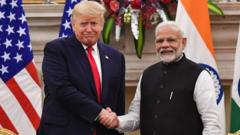Is the India-US Trade Deal in Trouble?

Is the "Big, Beautiful" India-US Trade Deal Slipping Out of Reach?
The potential for a transformative trade deal between India and the United States has captured global attention. With a deadline looming, negotiations have intensified, revealing both the promise and the perils of international commerce. Despite optimistic statements from officials on both sides, the reality of trade negotiations is proving to be complex and fraught with challenges. As the discussions unfold, it becomes evident that the path to a mutually beneficial agreement is littered with obstacles, particularly concerning agriculture, tariffs, and regulatory standards. This article explores the current state of the India-US trade negotiations, the key issues at play, and the implications for both economies.
Understanding the Stakes of the Trade Deal
The India-US trade relationship has long been characterized by both collaboration and contention. With a trade volume exceeding $150 billion, both nations recognize the potential for growth through enhanced economic ties. However, the discussions for a new trade deal have been complicated by differing priorities and domestic pressures.
According to reports, significant sticking points remain centered around agricultural access, auto components, and tariffs on Indian steel. The stakes are high, as both nations stand to gain substantially from a well-negotiated agreement. For India, the deal could mean increased access to the US market, while the US aims to reduce its trade deficit and secure better terms for its agricultural exports.
The Current State of Negotiations
As of now, negotiators from both countries are entrenched in discussions aimed at reaching a limited "mini-deal." This approach, while less ambitious than a full-fledged free trade agreement (FTA), may offer immediate benefits without the complexities of comprehensive negotiations. The urgency is palpable, with only a few days remaining before the self-imposed deadline.
The Role of Key Players
Key figures in this negotiation process include Indian Finance Minister Nirmala Sitharaman and US officials, including White House Press Secretary Karoline Leavitt. Their statements have oscillated between optimism and caution, reflecting the intricate dynamics of trade talks. While both sides express a desire for a "big, good, beautiful" agreement, the reality is complicated by entrenched interests and regulatory concerns.
Key Issues at the Heart of the Negotiations
Several core issues are impeding progress in the negotiations. Understanding these challenges is crucial for grasping the potential outcomes of the trade talks.
Agricultural Access
Agriculture remains a pivotal issue in the discussions. The US has long sought greater access to India's agricultural markets, viewing them as largely untapped. However, India has staunchly defended its agricultural sector, which is essential for food security and the livelihoods of millions of farmers. Key considerations include:
- Food Security: India prioritizes protecting its food supply and supporting local farmers.
- Market Access: The US aims to export products such as maize and soybeans, which could significantly impact India’s agricultural landscape.
- Minimum Support Prices (MSP): Indian negotiators are wary of concessions that could weaken these prices, which act as a safety net for farmers.
Non-Tariff Barriers
Another contentious issue is the regulation of imports, particularly India's non-tariff barriers. The US has criticized India's numerous Quality Control Orders (QCOs), which are designed to promote domestic manufacturing while restricting low-quality imports. These barriers, while aimed at safeguarding Indian consumers and industries, complicate the negotiations and could hinder US market access.
Tariff Structures
Tariffs on various goods, including steel and agricultural products, are a critical area of concern. Both nations have longstanding tariffs that they are reluctant to alter without significant concessions from the other side. Key points include:
- Indian Steel Tariffs: The US is pressing for reductions, which India is apprehensive about due to local economic concerns.
- Automotive Sector: The US has long sought lower tariffs on car imports, which remains a point of negotiation.
- Future Prospects: If negotiations fail, tariffs could remain unchanged or even escalate, further complicating trade relations.
The Potential Outcomes of the Negotiations
As the deadline approaches, experts predict various potential outcomes from the negotiations. While a comprehensive free trade deal may be out of reach for now, a limited agreement could still provide significant benefits to both parties.
Limited Trade Pact
One likely outcome is a limited trade pact that may focus on specific sectors rather than comprehensive changes. Such a deal could include:
- Tariff Reductions: India may agree to cut tariffs on certain industrial goods, particularly in the automotive sector.
- Selective Agricultural Access: There might be concessions on specific agricultural products, such as almonds and apples, albeit limited in scope.
- Strategic Commitments: The US may secure commitments for large-scale purchases of goods like oil and LNG, enhancing bilateral trade relations.
Implications of a Mini-Deal
A mini-deal, while less ambitious, could still yield immediate benefits, including:
- Boosting Economic Confidence: A successful negotiation could instill confidence in both markets, encouraging future investments.
- Pathway for Future Talks: Establishing a framework for future negotiations could pave the way for more comprehensive agreements down the line.
- Political Stability: A deal could provide political cover for both leaders, enhancing their standing domestically.
The Bigger Picture: Geopolitical Considerations
Beyond the immediate economic implications, the India-US trade negotiations also carry significant geopolitical weight. Both countries recognize the strategic importance of their relationship in the context of global trade dynamics, particularly amid rising tensions with other global powers.
Long-Term Strategic Partnership
Strengthening trade ties can be viewed as part of a broader strategy to counterbalance China's influence in the region. A more robust India-US trade relationship could enhance cooperation in various sectors, including technology, defense, and climate change initiatives.
Future of the Negotiations
As the deadline approaches, the future of the negotiations remains uncertain. The pressure is mounting, and both sides must navigate their domestic political landscapes while striving for mutual benefit. The outcome will undoubtedly influence the trajectory of India-US relations for years to come.
Conclusion: What Lies Ahead?
The India-US trade deal represents a pivotal moment in the economic relationship between two of the world's largest democracies. As negotiators continue their discussions, the potential for a "big, beautiful" agreement hangs in the balance. While challenges abound, the possibility of a limited trade pact offers a glimmer of hope for both nations. The outcome of these negotiations will not only shape bilateral trade but also impact global economic dynamics, making it a situation to watch closely.
FAQs
What are the main sticking points in the India-US trade negotiations?
The key issues include agricultural access, tariffs on steel, and non-tariff barriers related to quality control regulations.
What is a "mini-deal" in the context of trade negotiations?
A "mini-deal" refers to a limited agreement that addresses specific trade issues rather than a comprehensive free trade agreement.
How could the outcome of these negotiations affect global trade?
The results of the India-US trade talks may set a precedent for future trade agreements and influence global economic relationships, particularly in the Asia-Pacific region.
The ongoing India-US trade negotiations are a critical juncture for both nations and the global trade landscape. As the deadline approaches, stakeholders and observers alike are left to ponder: will a deal be reached that satisfies both parties, or will the complexities of trade negotiations once again thwart progress? #IndiaUSTrade #InternationalRelations #TradeNegotiations
Published: 2025-07-01 06:55:20 | Category: world



